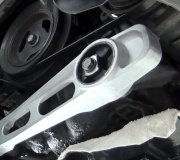Friday, April 21st, 2017 AT 6:18 PM
Hi, I recently had my motor mounts replaced and now my car is having problems switching gears it seems and revs up to 3000 or 4000 while driving (40 mph) before dropping back down to about 2000. I was at a red light and the car starting revving going as far as actually moving the car while my foot was on the brake. This was never an issue before the mounts were replaced. I took it back to the mechanic and he hooked it up to a computer and it did not read anything wrong. The check engine light never came on while out driving it either. Also, he checked the transmission for any leaks and there were none. Any suggestions?



